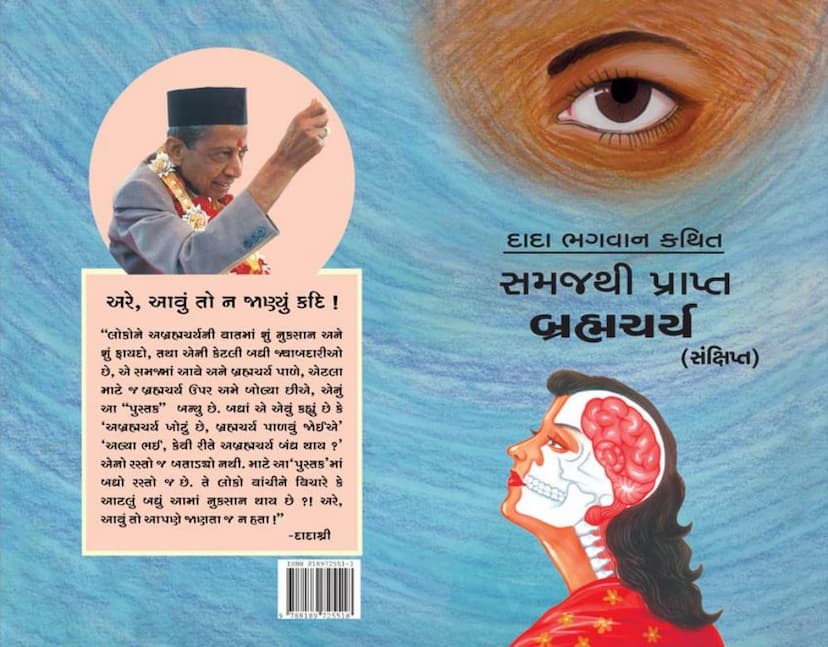Brahamacharya Sankshipt
Added to library: September 1, 2025

Summary
Here's a comprehensive summary of the Jain text "Brahamacharya Sankshipt" by Dada Bhagwan, based on the provided content:
Core Message: Brahmacharya Attained Through Understanding
The central theme of this book is that true Brahmacharya (celibacy or chastity) is not achieved through forced suppression or external rules, but through a profound, internal understanding and realization, as expounded by Dada Bhagwan. The text aims to illuminate the benefits of Brahmacharya and the drawbacks of its opposite (abrahma-charya) to guide individuals towards embracing it through wisdom.
Key Concepts and Teachings:
-
Conservation of Vitality (Veerya) and Wealth (Lakshmi):
- The book emphasizes the importance of not wasting two key elements in life: Lakshmi (wealth) and Veerya (vital energy/semen).
- While worldly wealth is often misused, Veerya is highlighted as the essence of food consumed, which sustains the body. Conserving Veerya is crucial for physical and spiritual well-being.
-
The True Nature of Brahmacharya:
- Brahmacharya is described as a "pudgal-saar" (essence of matter/physical essence).
- It is presented as a powerful tool for spiritual progress and a means to attain lasting happiness, distinct from fleeting worldly pleasures.
- The text clarifies that Brahmacharya is not about suppressing desires but about understanding their true nature and their illusory nature of happiness.
-
The Dangers of Sensual Indulgences (Vishay):
- Dada Bhagwan vividly describes sensual pleasures as "poisons" (vish) and "filth" (keechad). He compares them to excrement and rotten food, highlighting their inherently impure and repulsive nature when truly understood.
- The "wrong belief" (wrong belief) that sensual pleasures offer happiness is identified as the root cause of entanglement.
- The text warns against the illusory sweetness of sensual experiences, which ultimately leads to suffering and spiritual regression.
-
Understanding vs. Suppression:
- The book strongly advocates for understanding the true nature of sensual desires rather than forcefully suppressing them. Suppression is seen as leading to increased agitation.
- The "Akram Marg" (path of no effort) emphasizes gaining self-knowledge and understanding, which naturally leads to detachment from sensual objects.
- Dada Bhagwan explains that desire arises from ignorance and attachment, and true freedom comes from eradicating these roots through self-realization.
-
The Role of Knowledge and Understanding:
- True knowledge ("Gnan") is presented as the key to overcoming sensual desires. When one understands the transient and ultimately painful nature of sensual experiences, attachment naturally wanes.
- The importance of "purusharth" (self-effort) through self-awareness, introspection, and following the teachings of a Gnani Purush is stressed.
-
The Power of the "Akram Marg" and Gnani Purush:
- The Akram Marg, as taught by Dada Bhagwan, is a science that can help dismantle these attachments.
- Following the guidance and commands ("aagnya") of a Gnani Purush is crucial. Their words have the power to transform and purify.
- Dada Bhagwan emphasizes that His knowledge is a science that works directly.
-
The Importance of Conscious Effort and Practices:
- Awareness of Thoughts: Recognize and discard sensual thoughts as soon as they arise, like uprooting a weed.
- Pratikraman: The practice of acknowledging errors and seeking forgiveness (pratikraman) is vital for cleansing past impressions.
- Non-Identification: Maintain awareness that "I am not this body" and "I am not this mind," but rather the pure Self (Shuddhatma).
- Selective Diet: Certain foods (like root vegetables, excessive ghee/oil, or milk) can heighten sensual urges and should be consumed sparingly or avoided if Brahmacharya is a strong aim.
- Companionship: Associating with other Brahmacharis or those with similar intentions is beneficial. Avoid situations and company that trigger desires.
- Controlled Marriage (for householders): For those who are married, a balanced and respectful relationship with one's spouse, free from excessive indulgence or lust, is considered a form of Brahmacharya in this era. The focus should be on mutual understanding and avoiding sensual urges towards others.
-
Brahmacharya and Spiritual Progress:
- Brahmacharya is seen as a vital pillar for spiritual advancement, leading to enhanced mental clarity, speech, and physical strength.
- It is the foundation for higher spiritual states and the attainment of the Self.
- Those who practice Brahmacharya diligently are said to develop immense inner strength and clarity of thought, which aids in understanding spiritual knowledge.
-
Distinction between Pure Brahmacharya and "Discharge":
- The text addresses the phenomenon of "discharge" (galan) that may occur involuntarily. While involuntary discharge is not considered a transgression if one's intent is pure Brahmacharya, intentional discharge is seen as a serious lapse.
- The goal is to reach a state where such discharges cease entirely, signifying complete mastery.
-
The "No-Boundry" Danger:
- Living without clear boundaries, especially in relationships and sensual interactions, is highly discouraged. This "harr-aiya" (one who grabs whatever comes their way) behavior leads to negative consequences and hinders spiritual progress.
In essence, "Brahamacharya Sankshipt" is a practical guide that deconstructs the concept of Brahmacharya, demystifying it from mere external observance to an internal transformation based on profound understanding, self-awareness, and the grace of self-realization imparted by Dada Bhagwan. It encourages individuals to see through the illusion of worldly pleasures and to conserve their vital energy for the ultimate goal of spiritual liberation.